Business Economics: Analysis of Australian Manufacturing Sector
VerifiedAdded on 2021/06/17
|7
|1286
|198
Report
AI Summary
This report delves into the current state of the Australian manufacturing sector, highlighting a slowdown in growth attributed to rising energy costs and other economic factors. The analysis begins with an introduction to the importance of manufacturing in Australia, followed by a summary of recent trends, including a decline in the Purchasing Managers Index (PMI). The report examines the impact of increasing input costs, particularly for energy, and the role of the Australian dollar's value. The analysis incorporates economic theories, such as cost of production and profit maximization, to explain the challenges faced by manufacturers. Recommendations are provided to address the issues of energy costs and skilled labor shortages. The report concludes with a summary of key findings and references supporting sources.
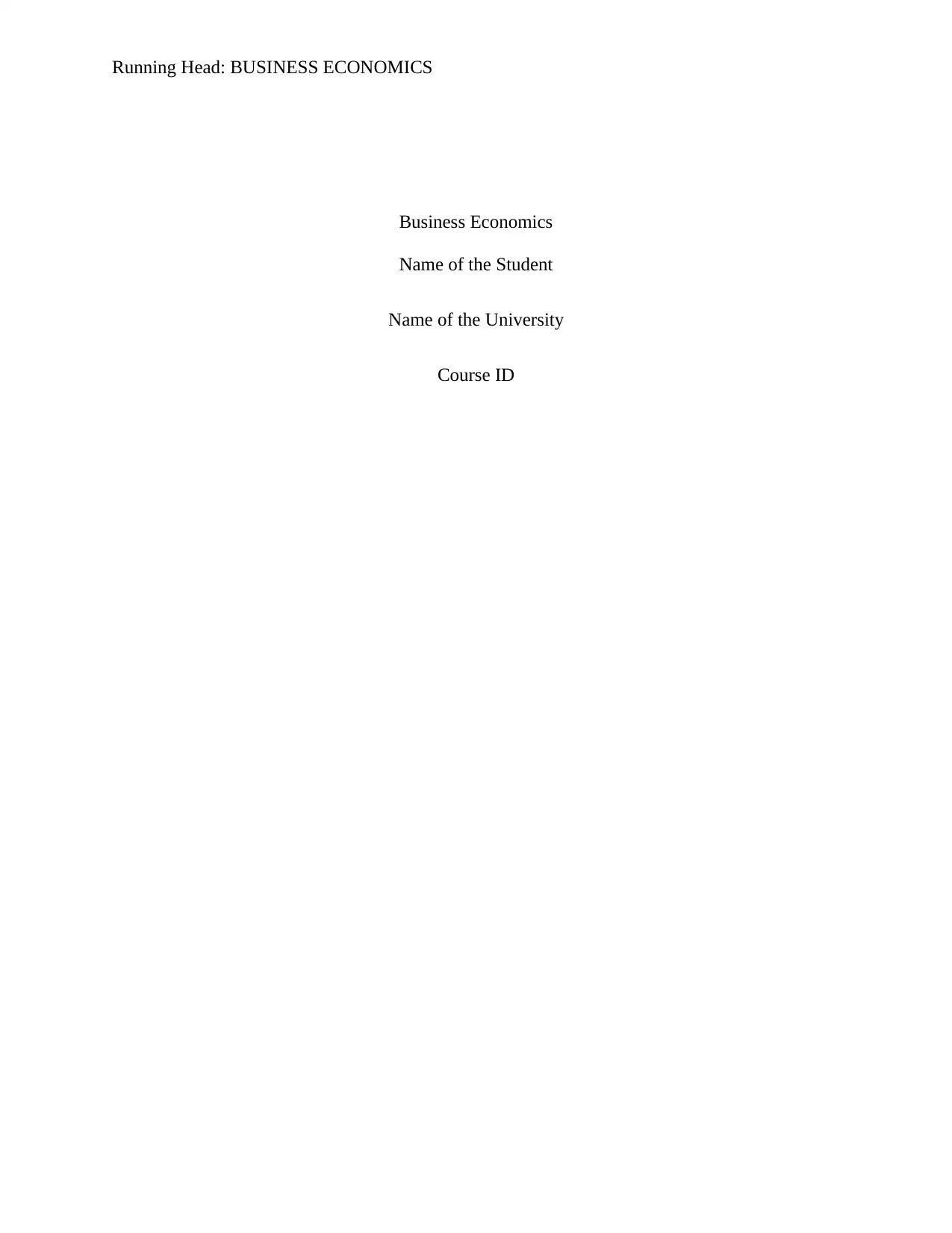
Running Head: BUSINESS ECONOMICS
Business Economics
Name of the Student
Name of the University
Course ID
Business Economics
Name of the Student
Name of the University
Course ID
Paraphrase This Document
Need a fresh take? Get an instant paraphrase of this document with our AI Paraphraser
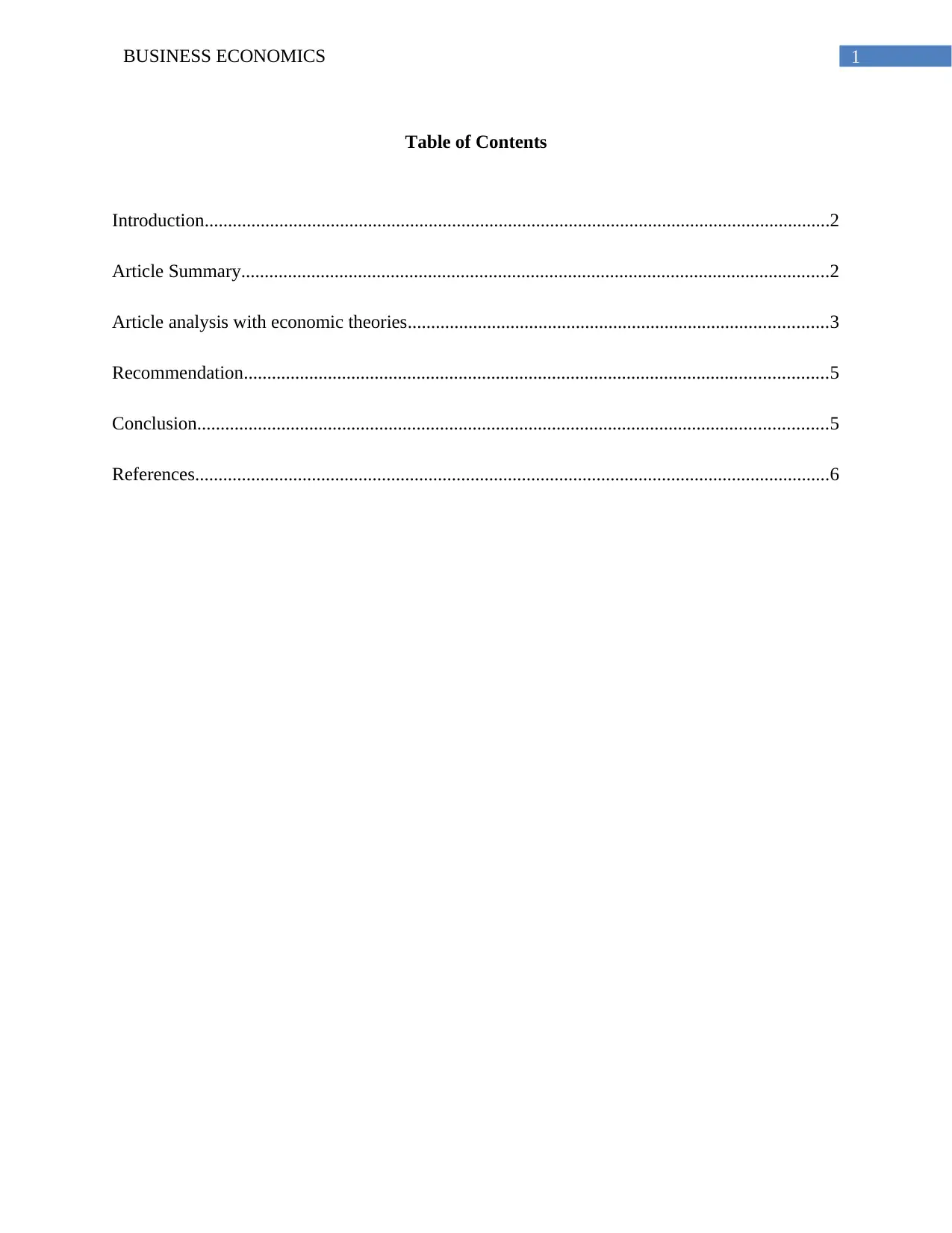
1BUSINESS ECONOMICS
Table of Contents
Introduction......................................................................................................................................2
Article Summary..............................................................................................................................2
Article analysis with economic theories..........................................................................................3
Recommendation.............................................................................................................................5
Conclusion.......................................................................................................................................5
References........................................................................................................................................6
Table of Contents
Introduction......................................................................................................................................2
Article Summary..............................................................................................................................2
Article analysis with economic theories..........................................................................................3
Recommendation.............................................................................................................................5
Conclusion.......................................................................................................................................5
References........................................................................................................................................6
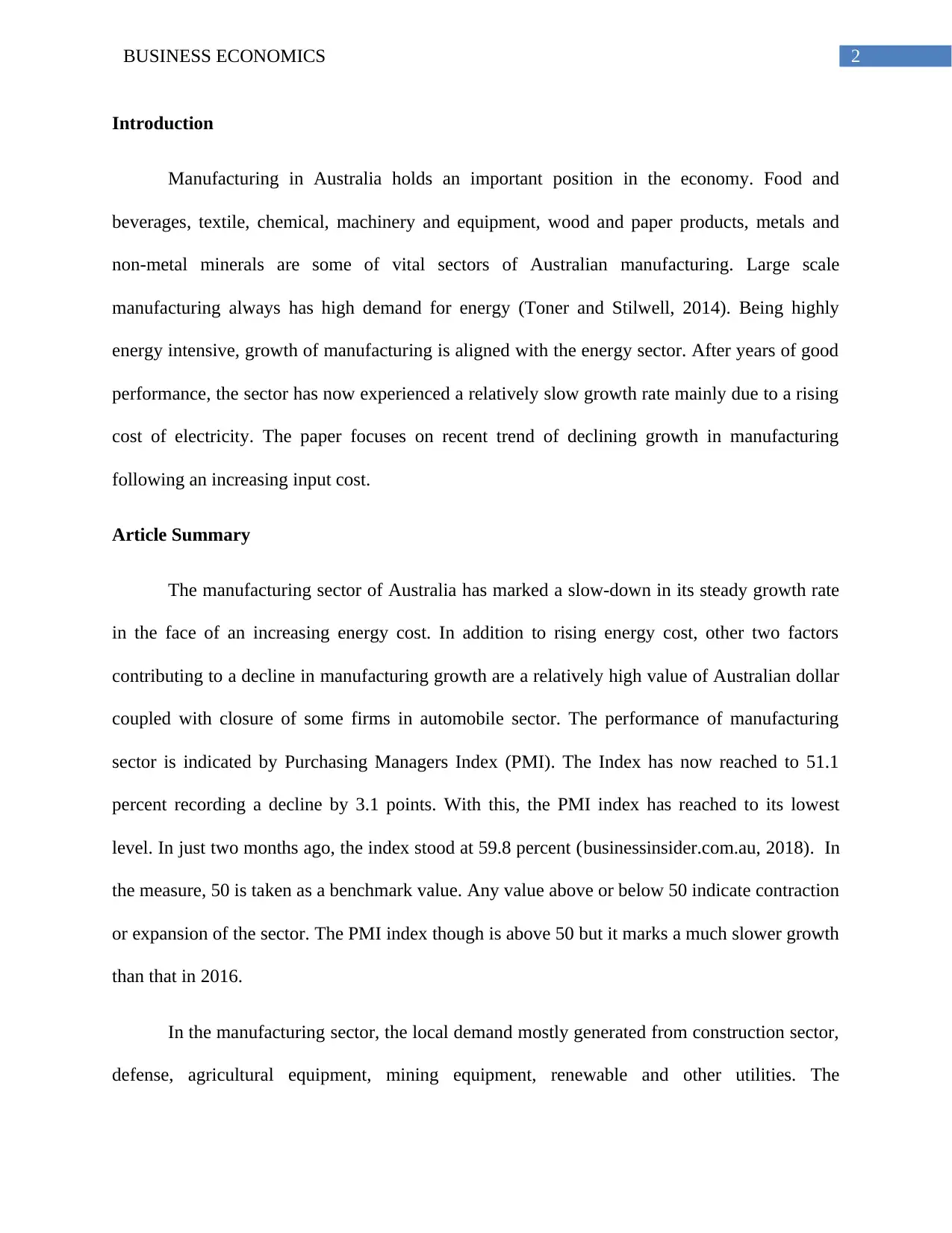
2BUSINESS ECONOMICS
Introduction
Manufacturing in Australia holds an important position in the economy. Food and
beverages, textile, chemical, machinery and equipment, wood and paper products, metals and
non-metal minerals are some of vital sectors of Australian manufacturing. Large scale
manufacturing always has high demand for energy (Toner and Stilwell, 2014). Being highly
energy intensive, growth of manufacturing is aligned with the energy sector. After years of good
performance, the sector has now experienced a relatively slow growth rate mainly due to a rising
cost of electricity. The paper focuses on recent trend of declining growth in manufacturing
following an increasing input cost.
Article Summary
The manufacturing sector of Australia has marked a slow-down in its steady growth rate
in the face of an increasing energy cost. In addition to rising energy cost, other two factors
contributing to a decline in manufacturing growth are a relatively high value of Australian dollar
coupled with closure of some firms in automobile sector. The performance of manufacturing
sector is indicated by Purchasing Managers Index (PMI). The Index has now reached to 51.1
percent recording a decline by 3.1 points. With this, the PMI index has reached to its lowest
level. In just two months ago, the index stood at 59.8 percent (businessinsider.com.au, 2018). In
the measure, 50 is taken as a benchmark value. Any value above or below 50 indicate contraction
or expansion of the sector. The PMI index though is above 50 but it marks a much slower growth
than that in 2016.
In the manufacturing sector, the local demand mostly generated from construction sector,
defense, agricultural equipment, mining equipment, renewable and other utilities. The
Introduction
Manufacturing in Australia holds an important position in the economy. Food and
beverages, textile, chemical, machinery and equipment, wood and paper products, metals and
non-metal minerals are some of vital sectors of Australian manufacturing. Large scale
manufacturing always has high demand for energy (Toner and Stilwell, 2014). Being highly
energy intensive, growth of manufacturing is aligned with the energy sector. After years of good
performance, the sector has now experienced a relatively slow growth rate mainly due to a rising
cost of electricity. The paper focuses on recent trend of declining growth in manufacturing
following an increasing input cost.
Article Summary
The manufacturing sector of Australia has marked a slow-down in its steady growth rate
in the face of an increasing energy cost. In addition to rising energy cost, other two factors
contributing to a decline in manufacturing growth are a relatively high value of Australian dollar
coupled with closure of some firms in automobile sector. The performance of manufacturing
sector is indicated by Purchasing Managers Index (PMI). The Index has now reached to 51.1
percent recording a decline by 3.1 points. With this, the PMI index has reached to its lowest
level. In just two months ago, the index stood at 59.8 percent (businessinsider.com.au, 2018). In
the measure, 50 is taken as a benchmark value. Any value above or below 50 indicate contraction
or expansion of the sector. The PMI index though is above 50 but it marks a much slower growth
than that in 2016.
In the manufacturing sector, the local demand mostly generated from construction sector,
defense, agricultural equipment, mining equipment, renewable and other utilities. The
⊘ This is a preview!⊘
Do you want full access?
Subscribe today to unlock all pages.

Trusted by 1+ million students worldwide
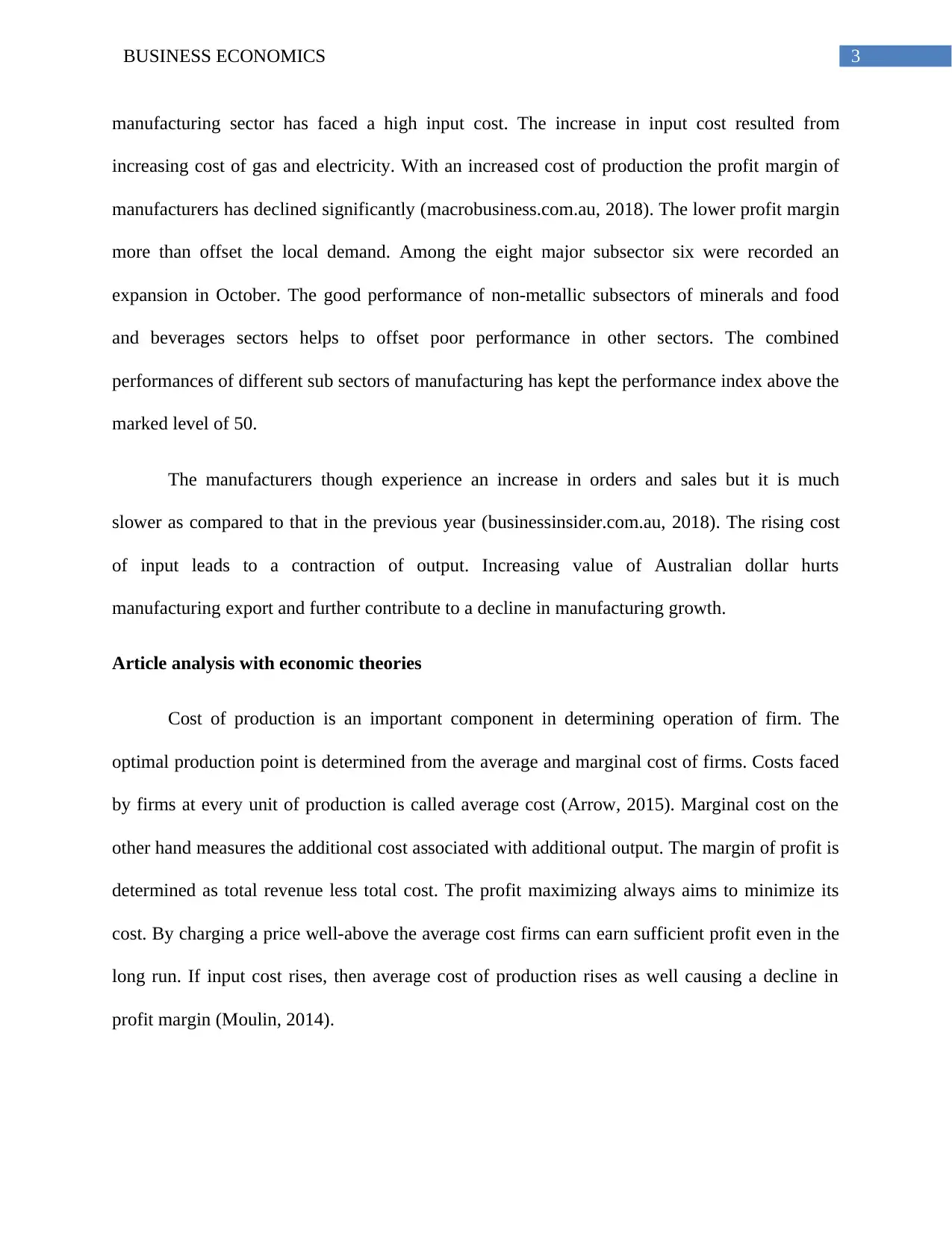
3BUSINESS ECONOMICS
manufacturing sector has faced a high input cost. The increase in input cost resulted from
increasing cost of gas and electricity. With an increased cost of production the profit margin of
manufacturers has declined significantly (macrobusiness.com.au, 2018). The lower profit margin
more than offset the local demand. Among the eight major subsector six were recorded an
expansion in October. The good performance of non-metallic subsectors of minerals and food
and beverages sectors helps to offset poor performance in other sectors. The combined
performances of different sub sectors of manufacturing has kept the performance index above the
marked level of 50.
The manufacturers though experience an increase in orders and sales but it is much
slower as compared to that in the previous year (businessinsider.com.au, 2018). The rising cost
of input leads to a contraction of output. Increasing value of Australian dollar hurts
manufacturing export and further contribute to a decline in manufacturing growth.
Article analysis with economic theories
Cost of production is an important component in determining operation of firm. The
optimal production point is determined from the average and marginal cost of firms. Costs faced
by firms at every unit of production is called average cost (Arrow, 2015). Marginal cost on the
other hand measures the additional cost associated with additional output. The margin of profit is
determined as total revenue less total cost. The profit maximizing always aims to minimize its
cost. By charging a price well-above the average cost firms can earn sufficient profit even in the
long run. If input cost rises, then average cost of production rises as well causing a decline in
profit margin (Moulin, 2014).
manufacturing sector has faced a high input cost. The increase in input cost resulted from
increasing cost of gas and electricity. With an increased cost of production the profit margin of
manufacturers has declined significantly (macrobusiness.com.au, 2018). The lower profit margin
more than offset the local demand. Among the eight major subsector six were recorded an
expansion in October. The good performance of non-metallic subsectors of minerals and food
and beverages sectors helps to offset poor performance in other sectors. The combined
performances of different sub sectors of manufacturing has kept the performance index above the
marked level of 50.
The manufacturers though experience an increase in orders and sales but it is much
slower as compared to that in the previous year (businessinsider.com.au, 2018). The rising cost
of input leads to a contraction of output. Increasing value of Australian dollar hurts
manufacturing export and further contribute to a decline in manufacturing growth.
Article analysis with economic theories
Cost of production is an important component in determining operation of firm. The
optimal production point is determined from the average and marginal cost of firms. Costs faced
by firms at every unit of production is called average cost (Arrow, 2015). Marginal cost on the
other hand measures the additional cost associated with additional output. The margin of profit is
determined as total revenue less total cost. The profit maximizing always aims to minimize its
cost. By charging a price well-above the average cost firms can earn sufficient profit even in the
long run. If input cost rises, then average cost of production rises as well causing a decline in
profit margin (Moulin, 2014).
Paraphrase This Document
Need a fresh take? Get an instant paraphrase of this document with our AI Paraphraser
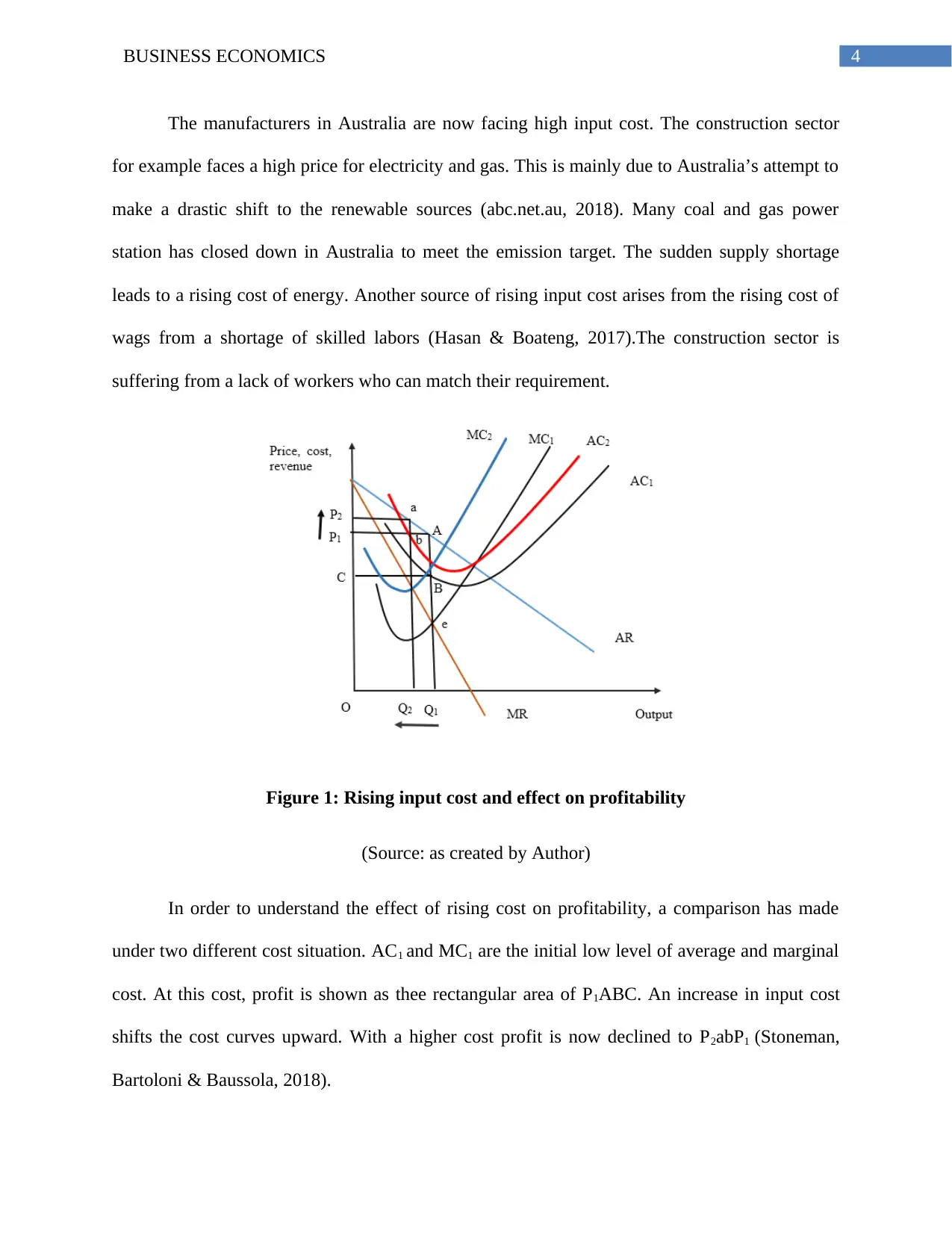
4BUSINESS ECONOMICS
The manufacturers in Australia are now facing high input cost. The construction sector
for example faces a high price for electricity and gas. This is mainly due to Australia’s attempt to
make a drastic shift to the renewable sources (abc.net.au, 2018). Many coal and gas power
station has closed down in Australia to meet the emission target. The sudden supply shortage
leads to a rising cost of energy. Another source of rising input cost arises from the rising cost of
wags from a shortage of skilled labors (Hasan & Boateng, 2017).The construction sector is
suffering from a lack of workers who can match their requirement.
Figure 1: Rising input cost and effect on profitability
(Source: as created by Author)
In order to understand the effect of rising cost on profitability, a comparison has made
under two different cost situation. AC1 and MC1 are the initial low level of average and marginal
cost. At this cost, profit is shown as thee rectangular area of P1ABC. An increase in input cost
shifts the cost curves upward. With a higher cost profit is now declined to P2abP1 (Stoneman,
Bartoloni & Baussola, 2018).
The manufacturers in Australia are now facing high input cost. The construction sector
for example faces a high price for electricity and gas. This is mainly due to Australia’s attempt to
make a drastic shift to the renewable sources (abc.net.au, 2018). Many coal and gas power
station has closed down in Australia to meet the emission target. The sudden supply shortage
leads to a rising cost of energy. Another source of rising input cost arises from the rising cost of
wags from a shortage of skilled labors (Hasan & Boateng, 2017).The construction sector is
suffering from a lack of workers who can match their requirement.
Figure 1: Rising input cost and effect on profitability
(Source: as created by Author)
In order to understand the effect of rising cost on profitability, a comparison has made
under two different cost situation. AC1 and MC1 are the initial low level of average and marginal
cost. At this cost, profit is shown as thee rectangular area of P1ABC. An increase in input cost
shifts the cost curves upward. With a higher cost profit is now declined to P2abP1 (Stoneman,
Bartoloni & Baussola, 2018).
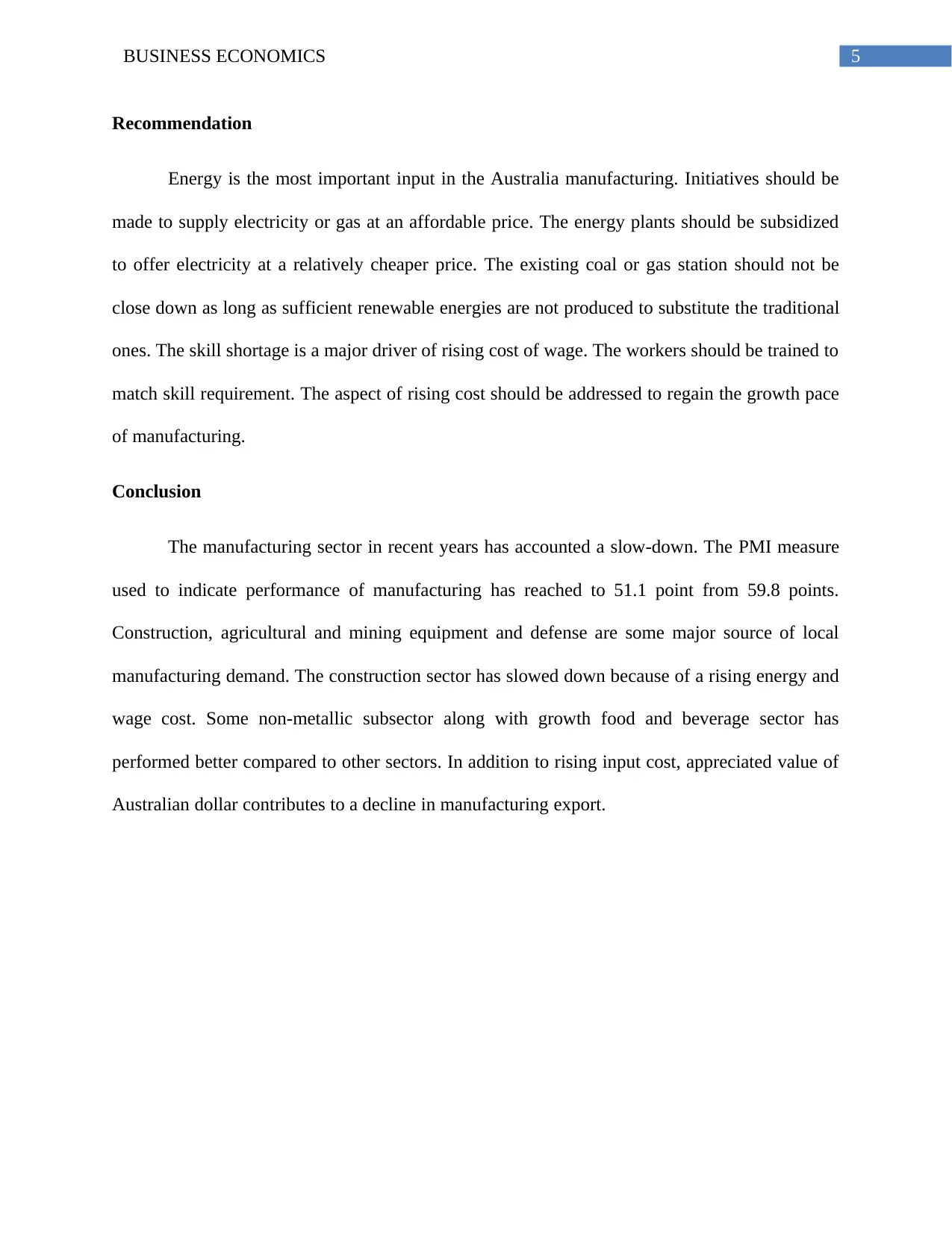
5BUSINESS ECONOMICS
Recommendation
Energy is the most important input in the Australia manufacturing. Initiatives should be
made to supply electricity or gas at an affordable price. The energy plants should be subsidized
to offer electricity at a relatively cheaper price. The existing coal or gas station should not be
close down as long as sufficient renewable energies are not produced to substitute the traditional
ones. The skill shortage is a major driver of rising cost of wage. The workers should be trained to
match skill requirement. The aspect of rising cost should be addressed to regain the growth pace
of manufacturing.
Conclusion
The manufacturing sector in recent years has accounted a slow-down. The PMI measure
used to indicate performance of manufacturing has reached to 51.1 point from 59.8 points.
Construction, agricultural and mining equipment and defense are some major source of local
manufacturing demand. The construction sector has slowed down because of a rising energy and
wage cost. Some non-metallic subsector along with growth food and beverage sector has
performed better compared to other sectors. In addition to rising input cost, appreciated value of
Australian dollar contributes to a decline in manufacturing export.
Recommendation
Energy is the most important input in the Australia manufacturing. Initiatives should be
made to supply electricity or gas at an affordable price. The energy plants should be subsidized
to offer electricity at a relatively cheaper price. The existing coal or gas station should not be
close down as long as sufficient renewable energies are not produced to substitute the traditional
ones. The skill shortage is a major driver of rising cost of wage. The workers should be trained to
match skill requirement. The aspect of rising cost should be addressed to regain the growth pace
of manufacturing.
Conclusion
The manufacturing sector in recent years has accounted a slow-down. The PMI measure
used to indicate performance of manufacturing has reached to 51.1 point from 59.8 points.
Construction, agricultural and mining equipment and defense are some major source of local
manufacturing demand. The construction sector has slowed down because of a rising energy and
wage cost. Some non-metallic subsector along with growth food and beverage sector has
performed better compared to other sectors. In addition to rising input cost, appreciated value of
Australian dollar contributes to a decline in manufacturing export.
⊘ This is a preview!⊘
Do you want full access?
Subscribe today to unlock all pages.

Trusted by 1+ million students worldwide
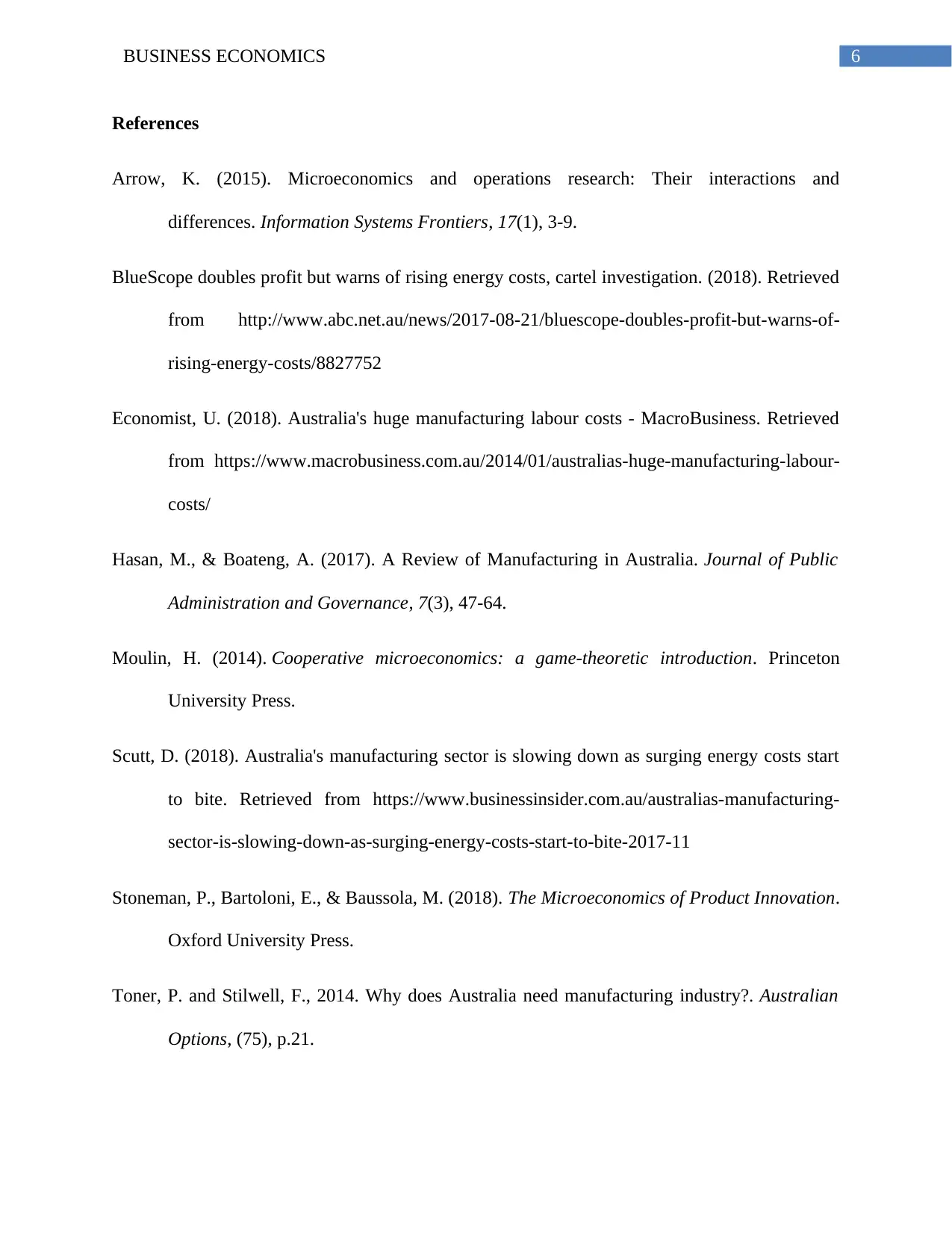
6BUSINESS ECONOMICS
References
Arrow, K. (2015). Microeconomics and operations research: Their interactions and
differences. Information Systems Frontiers, 17(1), 3-9.
BlueScope doubles profit but warns of rising energy costs, cartel investigation. (2018). Retrieved
from http://www.abc.net.au/news/2017-08-21/bluescope-doubles-profit-but-warns-of-
rising-energy-costs/8827752
Economist, U. (2018). Australia's huge manufacturing labour costs - MacroBusiness. Retrieved
from https://www.macrobusiness.com.au/2014/01/australias-huge-manufacturing-labour-
costs/
Hasan, M., & Boateng, A. (2017). A Review of Manufacturing in Australia. Journal of Public
Administration and Governance, 7(3), 47-64.
Moulin, H. (2014). Cooperative microeconomics: a game-theoretic introduction. Princeton
University Press.
Scutt, D. (2018). Australia's manufacturing sector is slowing down as surging energy costs start
to bite. Retrieved from https://www.businessinsider.com.au/australias-manufacturing-
sector-is-slowing-down-as-surging-energy-costs-start-to-bite-2017-11
Stoneman, P., Bartoloni, E., & Baussola, M. (2018). The Microeconomics of Product Innovation.
Oxford University Press.
Toner, P. and Stilwell, F., 2014. Why does Australia need manufacturing industry?. Australian
Options, (75), p.21.
References
Arrow, K. (2015). Microeconomics and operations research: Their interactions and
differences. Information Systems Frontiers, 17(1), 3-9.
BlueScope doubles profit but warns of rising energy costs, cartel investigation. (2018). Retrieved
from http://www.abc.net.au/news/2017-08-21/bluescope-doubles-profit-but-warns-of-
rising-energy-costs/8827752
Economist, U. (2018). Australia's huge manufacturing labour costs - MacroBusiness. Retrieved
from https://www.macrobusiness.com.au/2014/01/australias-huge-manufacturing-labour-
costs/
Hasan, M., & Boateng, A. (2017). A Review of Manufacturing in Australia. Journal of Public
Administration and Governance, 7(3), 47-64.
Moulin, H. (2014). Cooperative microeconomics: a game-theoretic introduction. Princeton
University Press.
Scutt, D. (2018). Australia's manufacturing sector is slowing down as surging energy costs start
to bite. Retrieved from https://www.businessinsider.com.au/australias-manufacturing-
sector-is-slowing-down-as-surging-energy-costs-start-to-bite-2017-11
Stoneman, P., Bartoloni, E., & Baussola, M. (2018). The Microeconomics of Product Innovation.
Oxford University Press.
Toner, P. and Stilwell, F., 2014. Why does Australia need manufacturing industry?. Australian
Options, (75), p.21.
1 out of 7
Related Documents
Your All-in-One AI-Powered Toolkit for Academic Success.
+13062052269
info@desklib.com
Available 24*7 on WhatsApp / Email
![[object Object]](/_next/static/media/star-bottom.7253800d.svg)
Unlock your academic potential
Copyright © 2020–2025 A2Z Services. All Rights Reserved. Developed and managed by ZUCOL.


